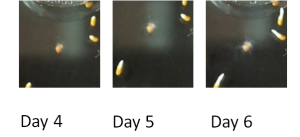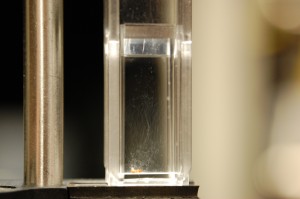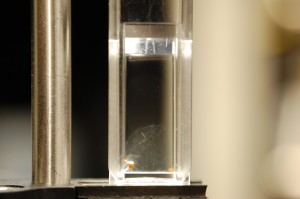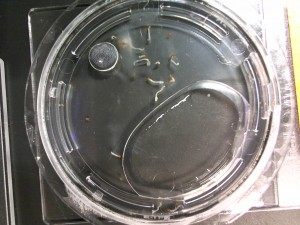Also taken Sunday and posted today. All caught up now.
DOI: 10.15200/winn.142722.23370 provided by The Winnower, a DIY scholarly publishing platform
Also taken Sunday and posted today. All caught up now.
DOI: 10.15200/winn.142722.23370 provided by The Winnower, a DIY scholarly publishing platform
DOI: 10.15200/winn.142722.24366 provided by The Winnower, a DIY scholarly publishing platform
 Looking over the data for the Repeating Crumley experiment I came across this. Typically while I count seed germination I put previous days in sequential order with the current set of pictures. This helps me to identify which seeds have changed (like time lapse). Looking at Day 6: 33% d2o tobacco seeds, I saw the above image and went back to see what happened in Days 4 and 5. Sure enough, the “fog” that is growing from that one seed was growing from the previous 2 days.
Looking over the data for the Repeating Crumley experiment I came across this. Typically while I count seed germination I put previous days in sequential order with the current set of pictures. This helps me to identify which seeds have changed (like time lapse). Looking at Day 6: 33% d2o tobacco seeds, I saw the above image and went back to see what happened in Days 4 and 5. Sure enough, the “fog” that is growing from that one seed was growing from the previous 2 days.
While the control is ok, I’m wondering if this is root hair or mold. It certainly can be mold. Looking at this makes me think I’ve seen this in previous trials of this experiment. And from what I’ve seen, it certainly doesn’t hinder the growth of the surrounding seeds. Especially since they’ve already germinated and they’ve been counted.
Just something to keep an eye on though.
DOI: 10.15200/winn.142722.24372 provided by The Winnower, a DIY scholarly publishing platform
I’d like to make it known that counting the arabidopsis seeds is next to impossible. The first seeds to germinate have grown so quickly that there is a mix of seeds that have shed their seed coat and seeds that have yet to germinate. This makes it impossible to count with any accuracy. I’m trying to tell if there is a difference in color between seeds that are germinating (or yet to germinate) and seeds that are no longer holding any plant material.
My guess is that darker browns indicated no plant material and light browns are germinating seeds. That is just a guess though. In the next trial I will have to do a small number of arabidopsis per sample (maybe less than 20).
DOI: 10.15200/winn.142722.24376 provided by The Winnower, a DIY scholarly publishing platform
So yesterday I mentioned how there was hair growth in the 33% D2O tobacco seed sample. I’m not sure what to make of it because I have proof that could possibly go either way.
In favor of root hairs, I have:

and

And in favor of fungus/mold I have:

Now you see, this last picture isn’t conclusive that it is in fact mold, but the reason I think it is is because the density of “cloud” is way thicker than in any of the root hair samples in a shorter amount of time. In a strange twist, this piece of evidence also occurs in the 33% D2O sample from RC1. I’m positive this also happened in one of the samples from Trial 3 as well, but I have no proof of the matter (and also possibly in the 33% D2O sample).
I’m using the first two images as proof of root hairs, because in both of those samples, the seeds have either failed to germinate or barely germinate and there are significant root hairs.
This is all very interesting indeed. Looks like a trip to UNM Biology is in order!
DOI: 10.15200/winn.142722.24380 provided by The Winnower, a DIY scholarly publishing platform
DOI: 10.15200/winn.142722.24386 provided by The Winnower, a DIY scholarly publishing platform
I find it interesting that the seeds in the 66% d2o tobacco seed sample are growing slower than usual. Hmmm..
Also it seems the fuzz in the 33% d2o tobacco seed sample has spread. What to do…
DOI: 10.15200/winn.142722.24390 provided by The Winnower, a DIY scholarly publishing platform
This is the last official post for this trial. I’m going to monitor the 66% d2o growth for the next week, because it seems the seeds have stopped sprouting.
DOI: 10.15200/winn.142722.24394 provided by The Winnower, a DIY scholarly publishing platform
Let’s just get right into rapid fire bullets:
I’m going to add time-lapse slideshows to the blog later to show the seed development. And I’ll keep watch over the seeds to see if anything else happens. I won’t be around next week (Florida vacation!) so I’ll start RC5 (and DDW4 as well) as soon as I return.
DOI: 10.15200/winn.142722.24400 provided by The Winnower, a DIY scholarly publishing platform
[portfolio_slideshow]
DOI: 10.15200/winn.142722.24405 provided by The Winnower, a DIY scholarly publishing platform